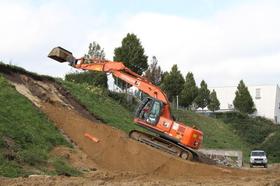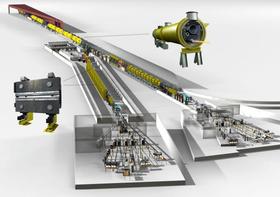First digging at the FLASH accelerator tunnel.
For years, the free-electron laser (FEL) FLASH at DESY has been generating X-ray laser light for an ever increasing user community. The construction started on 20 Sept. 2011 for the next expansion stage FLASH II, with the aim to serve more users and at the same time apply the most recent developments of FEL technology.
The extension of the free-electron laser FLASH is one of the strategic investments of the Helmholtz Association, providing nearly 30 million euros for the FLASH II project. Commissioning of the free-electron laser is planned for 2013. In a newly constructed experimental hall next to the existing FLASH hall, five measuring stations will gradually be available for the use of the highly demanded FEL light for research.
For this purpose, the existing superconducting linear accelerator is extended with a second tunnel section including a second line of undulators. These special magnets generate X-ray light by forcing up to 8000 electron bunches per second on a slalom run through the accelerator, thus emitting radiation. The laser light is then distributed to individually equipped beamlines, with the possibility to use wavelengths down to 4 nanometres. FLASH II will be equipped with variable field strength undulators emitting light pulses between 30 and 500 femtoseconds.
In the first construction phase, the connection to the existing FLASH accelerator tunnel is built, this makes necessary to remove the earth wall from the tunnel. The next step will be the construction of the sector in which the electrons are stopped after light emission.
Mid-October, parallel to the FLASH II construction, the photon science division organises the workshop “New Science Opportunities at FLASH” which is to explore the optimal use of the new research facilities.
(from DESY News)








